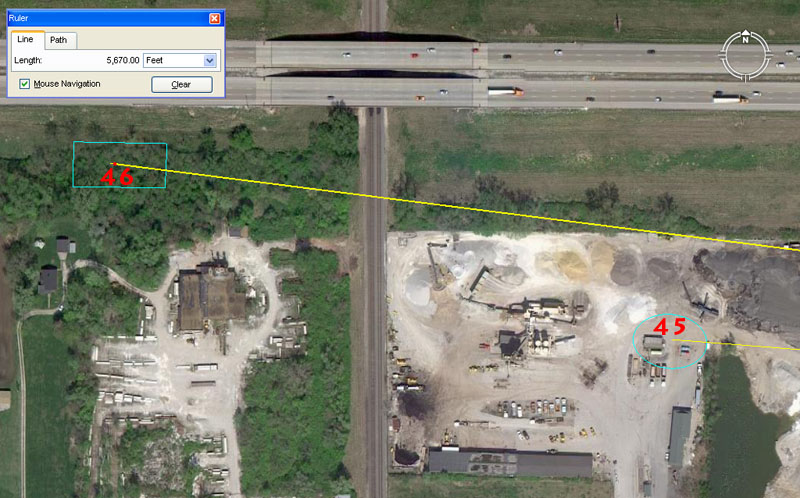
The University of Wisconsin, Milwaukee, map of the mound positions omits inclusion of mound 45, which has been thoroughly eradicated without trace. However, it appears clearly on the Patrick map and others and a very good approximation of it's former position can, therefore, be made by triangulations from other known mound positions. It sat within what is now a "sand & gravel" processing yard.
Melvin Fowler writes:
Mound 45 (N206W1138)
One of the rectangular mounds at the Cahokia site is Mound 45, shown on the
Patrick Map with its longer axis east-west. Mound 45 is located northwest
of Mound 44 and directly west of Mound 40 (see Figure 3.10). McAdams shows
Mound 45 as a 10- foot-high (3.05-meter) conical mound. Thomas, however, indicates
that the mound was in the northern one third of the west side of a large borrow
pit situated between Mound 44 and the railroad tracks. This borrow pit was
excavated in advance of a planned interstate highway over the area of Tract
ISA. Examination of aerial photos provides no clue as to the location and
condition of Mound 45. By 1933, when the Dache Reeves photos were made, all
of Section 34 had been disturbed by construction of both a canal that straightened
Cahokia Creek and a dog-racing track which probably intersected or cut into
Mound 45. The photos do show an interesting soil disturbance east of the track,
apparently where topsoil had been removed. There is no record of excavations
in Mound 45. See:The Cahokia Atlas, A Historical
Atlas of Cahokia Archaeology, pp. 115 - 116.
A "best-guess" estimate of Mound 45's former position would indicate that it probably sat 4500' out from the hub of Monk's Mound @ an azimuth angle of 94.5-degrees return. The sum of 45-degrees is, of course, 1/8th of a 360-degree circle, so mathematical progressions base upon 45 or lesser divisions of the same, were very important to ancient calculations.
With the mound sitting in the near vicinity of 4500' out, it appears obligatory that it would also have carried the coded distance of 4536', as this is one of the truly dynamic navigational numbers of antiquity. The Great Pyramid was built as a truncated pyramid, with a flat floor "altar" on top of it. The vertical height to that floor position is 453.6'. Sir William Flinders Petrie measured the heights of each tier of the pyramid up to the, now, somewhat jumbled stonework on the top. His final measurement for overall height was 5451.8", which is about 6-inches in excess of 453.6'. It appears that the intended height to the top of the altar floor was 264 Egyptian Royal Cubits of 20.61818182" each (453.6'). This cubit duplicates the length of the one in the Turin Museum and relates to calculating the equatorial size of the Earth according to the "6&7" navigational method. Remember, the length of the Great Pyramid @ 756' is 9072" or 4536" X 2.
It's possible that the ancient architects of the Great Pyramid used the 20.625" ERC ("11" family navigational method) for the height to the top of the altar floor. Therefore: 264 X 20.625" = 453.75'. Remember, the Great Pyramid, under its "11" navigational assignment, was 756.25' long or 9075" (4537.5" X 2). By either reading (453.6' or 453.75') the pyramid's height coded the equatorial circumference of the Earth, as did its slope angle of each face (51.84-degrees). Therefore: the 24883.2-mile equatorial circumference ÷ 51.84 (miles) = 480.
The 94.5 return azimuth angle from mound 45 to Monk's Mound is very strong navigational and lunar coding simultaneously. The Great Pyramid @ 756' per side was 94.5' X 8. The sum of 94.5' is 1/64th of 1-minute of equatorial arc (6048').
Mound 46 sits 5670' out at 97.2-degrees return azimuth angle. The distance aspect is strong lunar coding and the 6804-day lunar nutation cycle is 12-periods of 567-days (19.2 lunar months of 29.53125-days each). The 2551.5-days (7.2 lunar years) monitored within the lunisolar Sabbatical Calendar, is 45 periods of 56.7-days. A lunar year is 6.25 periods of 56.7-days.
The return angle is navigational coding and 97.2-miles would be 1/256th of the Earth's 24883.2-mile equatorial circumference. This segmentation is equivalent to dividing a circle, the outer perimeter of which represented the 24883.2-mile circumference, into 2, 4, 8, 16, 32, 64, 128 & 256 divisions.
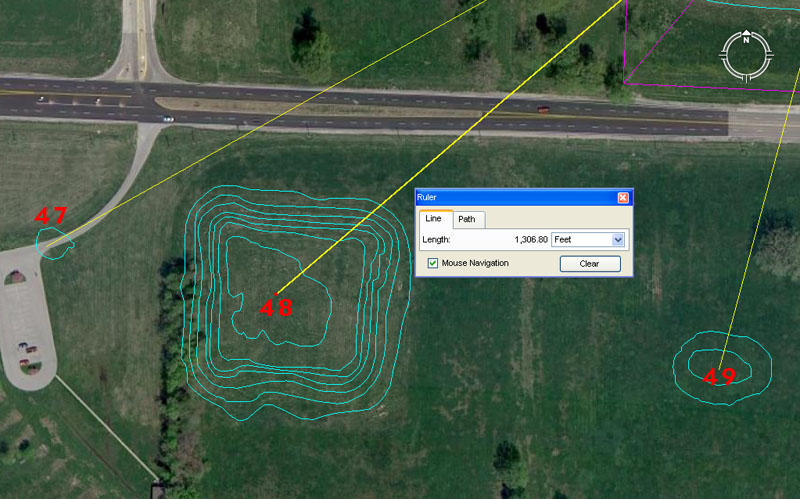
Mounds 47,48 & 49 are situated to the southwest of Monk's Mound.
Mound 47 sits 1575' from the centre hub position atop Monk's Mound @ 60.75-degrees return. The distance of 1575' is primarily lunar coding and a mathematical progression based upon this value will generate very useful values for tracking the lunar cycles. For example, there would be 432 periods of 15.75-days in the 6804-day lunar nutation cycle; 162 periods in the 2551.5-day lunar period monitored within the lunisolar Sabbatical Calendar or 22.5 periods of 15.75-days in the 354.375-day lunar year. Inasmuch as there are 16 X 22.5-degrees in a 360-degree circle, a calibrated stone disc, based upon increments of 15.75-days (378-hours) would work perfectly for tracking 3 lunar cycles separately. Note: The half-value length for the Great Pyramid is 378'. The sum of 157.5' would equate to 1/4th of a Greek stadia (stadium) length.
Simultaneously to mound 47 carrying tutorials based upon 1575', the merits of 1562.5' would also have been taught. This value generates very useful numbers used in navigation and lunar calculations.
The 60.75-degrees return angle from the crown of mound 47 to the hub on Monk's Mound is strong lunar coding. There would be 112 periods of 60.75-days in the 6804-day lunar nutation cycle and 42 periods in the 2551.5-day count (7.2 lunar years).
Mound 48 sits 1306.8' from the hub atop Monk's Mound @ a return angle of 49.5-degrees. This very important mound was for teaching student navigators the equatorial circumference of the Earth under 3 systems.
1. The Earth is 24883.2 Greek miles in circumference = 130636800'. This is the literal system built into the base dimensions of the Great Pyramid and, although a small amount of known error existed in consideration of the true equatorial circumference (about 160.2-miles shortfall) the system was very fluid and easy to manipulate for positional plotting at sea. Also, all of the lunar cycle values could be integrated within the same system. This "6&7" system was dynamic.
2. The Earth is 24750 English miles in circumference = 130680000'. This is the second system built into the base dimensions of the Great Pyramid and, although it too accepted a small amount of known error (152-miles), the system was excellent for very fluid positional plotting at sea. This system would convert "11" based sea legs into sexagesimal circumferences, for easy calculations of degree angles back to the point of departure or onwards to the destination, despite many course changes when tacking with the wind (zigs & zags across the ocean).
3. The Earth is 24883.2 English miles in circumference = 131383296'. This third system used highly factorable numbers to represent the "true" equatorial circumference, for a shortfall of only 18.8-miles. Although the system was factorable, it was unsuitable for positional plotting, as it generated cumbersome values when converting linear sea legs into circumferences for precise angle determinations.
Most voyages were regional (say within the Mediterranean or across the Atlantic) so the "6&7" or "11" systems of navigation were more than sufficiently accurate for grid referencing the Earth into latitudinal or longitudinal sectors.
The 49.5-degrees return angle from mound 48 to Monk's mound is navigational coding under the "11" system of navigation and 4950-miles would be 1/5th of the 24750-mile equatorial circumference.
Mound 49 sits 1008' from the hub position atop Monk's Mound @ a return azimuth angle of 15-degrees. The distance is 10-seconds of equatorial arc of 100.8' each. In other words, 100.8' (1-second of arc) X 60 = 6048' (1-minute of arc) X 60 = 362880' (1-degree of arc) X 360 = 130636800 (the equatorial circumference). Again, tutorials at this mound would have included 10-seconds of arc readings in the other systems.
The return azimuth angle from this mound is 15-degrees, which is 1/24th of 360-degrees.
RECONSTRUCTION OF ERADICATED MOUNDS AFTER 1981.
It's important to realise that within sections of Cahokia Mounds State Historic Park, considerable reconstruction has occurred since 1981 to create the park that presently exists. The State had to buy up many privately owned homes in a subdivision and remove both the buildings and the roads. When the subdivision was first put in, several mounds had been flattened to create level ground upon which to build the houses and roads. After 1981, some effort was expended to recreate the old mound positions at approximately original locations and dimensions. This was, of course, to give visitors to the park a feeling and spectacle of what the complex would have looked like in its heyday. See: http://www.nps.gov/oia/topics/Cahokia.pdf
|
Since 1981, the following changes have occurred: a) The State of Illinois transferred the site out of the State Park system and established the property as a State Historic Site, establishing its primary function as site protection and public interpretation; consequently most recreation areas were concentrated or removed. b) New 33,000 sq. ft. (3066 sq. m) Interpretive Center and parking lot; old museum and parking lot removed. c) The Woodhenge was reconstructed. d) The state now owns over 2100 acres (850 hectares) of the site, including nearly all of the northern, central, and southern areas – a 60% increase in state ownership over the 1300 acres (540 hectares) owned at the time of the inscription in 1982. The state now owns over half of the site as defined by the US National Historic Landmark boundary, including 70 mounds. e) One entire 40-acre housing subdivision consisting of 68 houses acquired and restored as Grand Plaza area. Six mounds along the east side of the plaza that were destroyed during construction of the subdivision were recreated to approximate original dimensions. f) As more property was acquired and protected, old park and subdivision roads and buildings were removed and landscape restored: trees and buildings blocking landscape view of mound layout and site organization were removed from central part of site; small and remote mounds were removed from agricultural production; trees were removed from other mounds - dense erosion resistant grasses were planted on the mounds; and 40 hectares (100 acres) were taken out of cultivation and established in native prairie plants and grasses. Interpretive and hiking trails were established. |
|
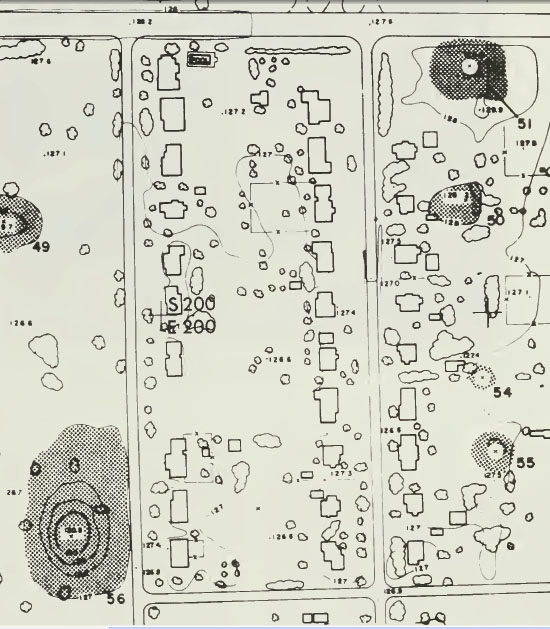 |
We now move into a large area where a subdivision was systematically removed after 1981. For the purposes of this study, the former positions of all mounds are fixed according to the University of Wisconsin, Milwaukee map, which remains the most authorative study. The map, a section of which is shown above, was the result of very careful analysis by UWM, which collated all historical information that existed related to the mounds, before recording the positions. The subdivision shown above in the UWM map is now completely gone and this land, situated just SE of Monk's Mound, has been absorbed into the newly extended park.
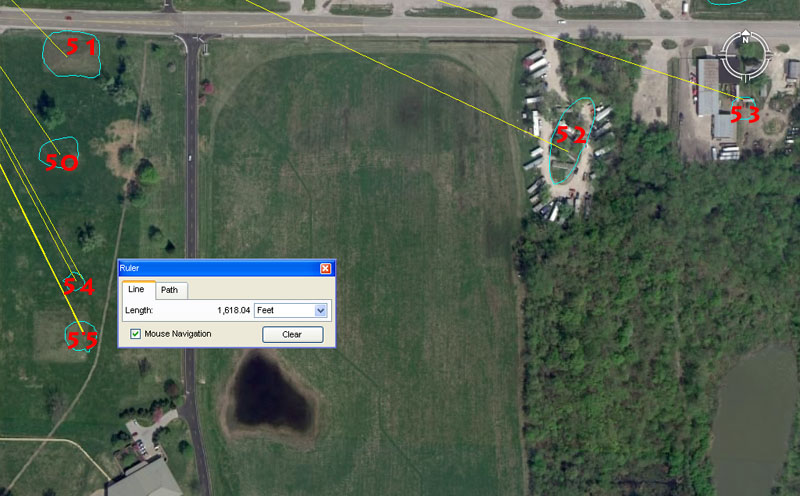
Mounds 50, 51, 54 & 55 were mostly eradicated when a subdivision was built in that section. Mound 53 partially survived in a trailer park and whatever was left of mound 53 was removed to make way for an industrial site. Prior to the encroachment of urban sprawl and industrialisation, farmer's ploughs or mound mining (selling soil for fill) had severely diminished many mound in size and all but obscured their presence.
Mound 50 sits 1166.4' from the hub position on Monk's Mound @ an azimuth angle of 145.8-degrees. This distance would equate to 1200 so-called Roman feet, although the length is found within ancient open-air university sites that preceded the Romans by 2500-years or so. This incremental value was important for remembering the equatorial circumference of the Earth and the sum of 1166400' would be 1/112th of the 130636800' equatorial circumference. This calibration was equivalent to dividing the Earth into 56 & 112 divisions. There were 56 posts on the Aubrey post circle at Stonehenge for various kinds of lunar or navigational-based counts, as well as triangulation fixes onto ascending or alighting star positions, as stars hovered just above the top of the circumnavigating henge embankment. The henge embankment acted as a false horizon, similar to what a navigator would see in the middle of a featureless ocean at night.
The degree angle is similar coding and a mathematical progression based upon 1458 will generate many if the same values as one based upon 11664. The fact of the matter is that 1458 X 8 = 11664. The Egyptian Theban volume was 11664 cubic inches.
Mound 51 sits 972' from the hub position on Monk's Mound @ 136.08-degrees. This mound carries, essentially, the same coding in both distance out and angle away from Monk's Mound hub. The values generate mathematical progressions that relate to navigation and the cycles of the Moon. The sum of 97.2-miles would be 1/256th of the 24883.2-mile equatorial circumference, which is equivalent to dividing up the Earth by 4, 8, 16, 32, 64, 128 & 256, etc.
The 136.08-degrees azimuth angle homes-in on a much-used value to describe the rate of speed that the Earth spins in a 24-hr period. Therefore 24883.2-miles ÷ 24 = 1036.8 MPH. This value, or lesser divisions thereof, was used by several ancient nations in "cubic capacities" of goods sold in the marketplace. It's probable that the side length of Monk's Mound was intended to be 1306.8', based upon Reed's 1968 core-drill survey.
In this case, related to distance and angle, the sum of 13068 ÷ 972 = 14.
Mound 52 sits 2250' from the hub atop Monk's Mound @ an azimuth angle of 115.2-degrees. The value 2250 would have been taught in homage to the 22.5-degrees that represents 1/16th of 360-degrees. The same mound crown would have carried a tutorial for 2268' which would equate to 3 side lengths of the Great Pyramid @ 756' per side. The value is both strong lunar and navigational coding simultaneously and the sum of 2268' is 1/160th of 1-degree of equatorial arc.
The angle value of 115.2 is a strong, multi-use, navigational number and 115.2-miles is 1/216th of the 24883.2-mile circumference. The sum of 216' (108 X 2) is 1/28th of 1-minute of arc (6048'). Both the English and American "bushel" volumes derive from very ancient volume measures and are supposed to be exactly 2160 cubic inches (coding the number of years the Sun spends in each of the 12 Houses of the Zodiac during the 25920-year cycle of Precession).
There were 30 lintel stones lying horizontally atop the Sarsen uprights at the Sarsen Circle of Stonehenge, each averaging 11.52'.
Mound 53 sits 2640' from the hub position on Monk's Mound @ an azimuth angle of 108-degrees. The distance of 2640' is half a mile of 5280'. The value carried by the angle out from the hub atop Monk's Mound (108-degrees) is half of 216 and the sum of 108' would be 1/56th of 1-minute of arc (6048').
Mound 54 sits 1485' from the hub atop Monk's Mound @ an azimuth angle of 151.875-degrees. This distance is 1/4th of an ancient Scottish mile of 5940'. The angle is navigational & lunar coding simultaneously. The sum of 151.875' (1517/8ths) is 1/32nd of a Roman mile (4860'). The angle onto this mound would also have been read as 151.2-degrees (two sides lengths of the Great Pyramid @ 756' per side = 1512' or 1/4th of 1-minute of equatorial arc).
Mound 55 sits 1618.04' from the hub position on Monk's Mound @ an azimuth angle of 153.6-degrees. The UWM map shows a small residual mound configuration amongst the housing subdivision, whereas nowadays a whole new and substantial mound has been rebuilt within the park. Although the UWM position still touches down on the new mound, the new epicentre is more to the West.
The UWM position carries a dynamic code related to the PHI ratio (1: 1.6180339) and sits a coded distance of 1618.04' out at an azimuth angle of 153.6-degrees. The distance would also have been read according to "rounded" PHI and represent 1620'.
The 153.6 value is navigational and 153.6-miles X 162 = 24883.2-miles.
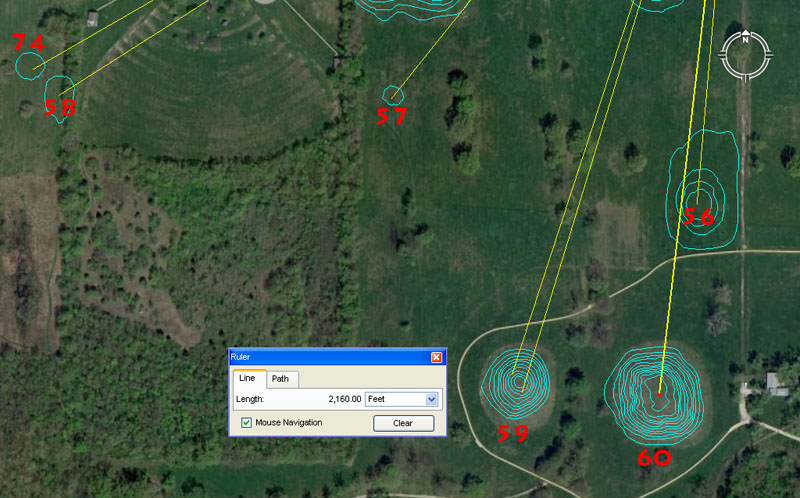
Mounds 56, 57, 58, 59& 60, with an out of sequence mound 74 sitting alongside mound 58.
Mound 56 sits 1600' out from the hub position atop Monk's Mound @ a return azimuth angle of 15-degrees. The 360-degree compass was divided up into divisions of 8, 16 or 32 and this "octal" method of dividing the circle often shows up in North American Indian designs. Also, some North American Indian tribes counted in divisions of eight, by counting the spaces between the fingers, rather than the fingers themselves. Simultaneously, the 360-degree compass was divided up according to the ancient Babylonian sexagesimal system (base 60) and 15-degrees is 1/24th of 360-degrees.
Mound 57 sits 1650' out @ an azimuth angle of 218.75-degrees. The distance is 300 ancient fathoms, 100 rods or perches or 1/10th of an ancient league (16500' or 3.125-miles). The 218.75-degree angle, used in a mathematical progression generates navigational and lunar numbers and the sum of 218.75' is 1/24th of a 5250' Greek mile.
Mound 58 sits 2376' out @ 237.6-degrees. Generally, ancient architects of the open-air-universities would design the layout of markers in such a way as to generate unrelated values of distance and angle onto an outlying marker. This was, obviously, so that "working out the maze" didn't become too easy and there were always two values to find through precise surveying. In a few cases, however, the wily architects made both the distance and angle an expression of the same dynamic value, as in this instance.
The value 2376 is navigational and the sum of 237.6' would be 1/25th of an ancient Scottish mile of 5940'. This distance at Cahokia Mounds would be 1/55000th of the 24750-mile equatorial circumference.
Mound 74 sits 2400' out @ an azimuth angle of 240-degrees. The architects who designed the layout have, again, made the distance and angle coding hit upon the same value.
Mound 59 sits 2240' out at an azimuth angle of 196.875-degrees. The coding would also have included 2200' (navigation) @ 198-degrees (198-miles would be 1/40th of the diameter of the Earth).
The sum of 2240 lbs became the English ton (20 cwt of 112 lbs each) and this use of "14" & "16" based values has a pedigree back to ancient Egypt and other civilisations of antiquity. For example, the ancient Egyptian Sep, Deben & Kite weights system was based upon the (traditional) pound of 7000 grains and the English pound derives directly from that. There was a Deben of 700 grains (1.6 ounces) and a Kite of 70 grains (.16 of an ounce).
Similarly, the degree angle, in this case, (196.875) was strongly represented as a weight in ancient Egypt for measuring out quantities of gold. The Beqa weight was 196.875 grains and this same gold standard was adopted by the latter Greeks and Romans. The Greeks called their 196.875-grain weight a Tridrachm and the Romans called theirs a Semuncia. The coding contained within this value is primarily lunar, but also navigational. The sum of 19.6875-days (1911/16ths ... 472.5 hours) would be 1/18th of a lunar year (354.375-days). Equally, the sum of 19.6875' would be 1/32nd of a Greek stadia of 630'.
Mound 60 sits 2160' out @ an azimuth angle of 186.624-degrees.
The sum of 2160-years is, of course, the number of years the Sun spends in each House of the Zodiac during the cycle of Precession. The Moon is 2160-miles in diameter. The degree angle relates to the equatorial circumference of the Earth and 186624' would be 1/700th of the 24883.2 Greek mile distance around the Earth.